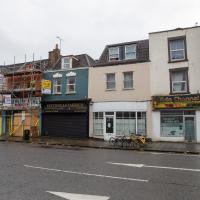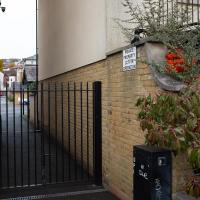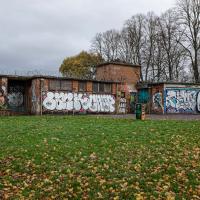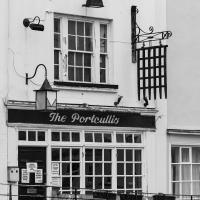Tagged: wall
Sunday Morning
15 Nov 2020
My friend Sarah mentioned the high tide and I managed to drag myself out early, though still a little late. We nearly drowned in torrential rain, but the weather changed quickly and we ended up walking over to Bedminster in sunshine.
Someone told me this meant "the young duck", but I can't confirm that. "de jonge eide" would apparently mean "the young egg" in Dutch, but Google Translate just says "the young iede" if I try to translate the name with the spelling "iede" that's on the sign, so maybe it's not Dutch. ("duck" in Dutch would apparently be "eend").
I know "eider" (as in the eider duck/eiderdown) comes from Swedish, but I don't think it's Swedish, either. I'm not very good with languages, that's for sure.
I did a loop around this block. There probably aren't many people who cross this bit of grass that aren't very local indeed.
Sunday Afternoon
15 Nov 2020
A walk back from Bedminster to my place, mostly down Duckmoor Road, which I found a little dull—probably because it reminded me a little of the suburbs I grew up in on the outskirts of London—then held up slightly by some filming on Ashton Avenue Bridge. They were trying not to let the crowds build up too much in between takes, it seems, so it wasn't a long delay.
Dowry Square Jaunt
16 Nov 2020
A quick lunchtime jaunt to Dowry Square, which is very close to me but, being effectively a cul-de-sac as well as a square, I've probably only circumnavigated a couple of times in the last couple of decades.
I believe the Hotwells Pine owners decided to retire, like the owner of the fish & chip shop a little further along. Asia Channel did excellent food, but had some kind of family crisis and closed down quite abruptly, sadly. The dentist on the end seems to do a good trade, and Hotwells Fabrics is still going. The one in between them and Asia Channel has been threatening to turn into a deli for a few years now, I think, but perhaps that's fallen by the wayside. Seems a terrible shame when we could do with a few more good local shops. Hotwells has definitely thrived more than this, in the past.
I wonder what else he did? Dowry Square was very popular with the medical profession, which sprung up around the hot well, mostly because of all the poor buggers dying of varous ailments who came along to be cured by drinking mildly contaminated hot water.
Jaunt to a Closed Coffee Shop
17 Nov 2020
A fruitless wander, as Spoke and Stringer (who I thought might do a decent flat white) were closed, and the only other harbourside inlet offering were a bit too busy to wait at, especially as I'd spent some time wandering some of the convolutions of Rownham Mead. This last congeries of dull alleyways and brown-painted garages was at least somewhere I've never been before, in parts.
A lot of folks aren't fans of the architecture at Poole's Wharf, but I'd love to live in one of these houses.
In which our intrepid hero levels up.
Quite a line-up. I'm afraid to say I've only read the obvious writer here; I've just popped Angela Carter's The Bloody Chamber on my "to-read" list to try and make up for that, but it's quite a long list right now.
Okay, I successfully reached Greville Smyth the long way round. Of course, there's no coffee van to be found now I'm here. Curses!
Quick Coffee
19 Nov 2020
A sunny day, and though I should have probably headed for less well-travelled territory I just headed over to the Marina to grab a flat white from Imagine That's horsebox café.
What, should I keep clear from this side? I'm assuming that this doesn't actually affect anything on dry land...
Clifton Village Mini Wander
20 Nov 2020
Just a quick wander up the hill to get a flat white from Twelve. I really enjoyed the spooky mannequin (?) in the window.
I mentioned to Christopher Fowler that I'd always thought this pub sign would be a good murder weapon for one of the Bryant and May books, but of course he mostly deals in London, not Bristol.
Bedmo and Ashton Court
21 Nov 2020
A rather more wide-ranging weekend wander with Sarah and Vik, taking in some mock Tudor bits of Bedmo (I should note that I've subsequently been corrected to "Bemmie", but I'm an outsider and have been calling it "Bedmo" for short for decades...), a chunk of Ashton, a path up Rownham Hill called Dead Badger's Bottom(!), The Ashton Court estate, a bit of the UWE campus at Bower Ashton, and some of the Festival Way path.
Underpass
25 Nov 2020
A quick lunchtime jaunt for coffee. I've often wondered about the dots on the wall of the underpass. Apparently they're not intelligible Braille. Maybe it's Marain :D
Apparently this isn't Braille. Could be Marain, I suppose. It's also on some of the pillars, from what I remember.
And Back Down the Hill from the Flu Jab
21 Nov 2020
This is my return from getting my annual flu jab at Christ Church, as explained in more detail in my wander up the hill.
This is now the Bristol School of Dancing. Their website says:
Built in 1893, it stands in the garden of 20 Vyvyan Terrace and it is rumoured that it was once a Swedish diplomatic building that contained a gymnasium. This is probably why on either side of the main entrance the words “Swedish Gymnasium” are carved.








































